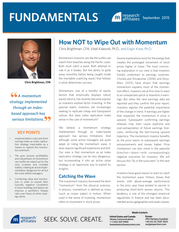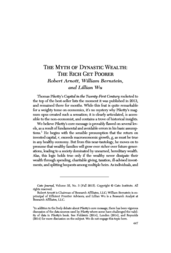Description
January 2015
SIMPLYSTATED
Endnotes
1. The output gap is defined as the percentage deviation
of actual real GDP from potential real GDP. Potential
GDP is typically estimated as the level of production
consistent with full employment and stable inflation
(see for instance the Congressional Budget Office estimates for the United States).
2. Another source of noise comes from the fact that GDP
values are revised in subsequent months after they
are reported. Although the mean revision is close to
zero on average, revisions can have magnitudes greater than 2% in some quarters. Research has shown that
U.S.
revisions cannot be forecasted with significant accuracy. See Faust, Rogers, and Wright (2005). 3. Solow (1957) and Jorgenson and Griliches (1967) are seminal works in the growth-accounting literature. References Arnott, Robert D., and Denis B. Chaves.
2012. “Demographic Changes, Financial Markets, and the Economy,” Financial Analysts Journal, vol. 68, no.
1 (January/February):23–46. Barro, Robert J. 1991. “Economic Growth in a Cross Section of Countries,” Quarterly Journal of Economics, vol.
106, no. 2 (May):407–443. Cohen, Patricia. 2014.
“3rd-Quarter Growth Rate Is Revised Up, to 3.9%.” New York Times (November 25). Faust, Jon, John H. Rogers, and Jonathan H. Wright.
2005. “News and Noise in G-7 GDP Announcements.” Journal of Money, Credit, and Banking, vol. 37, no. 3 (June):403–420. Feenstra, Robert C., Robert Inklaar, and Marcel P.
Timmer. 2013. “The Next Generation of the Penn World Table.” http://www.rug.nl/research/ggdc/data/penn-world-table Fernald, John G. 2014.
“Productivity and Potential Output Before, During, and After the Great Recession,” Working Paper, Federal Reserve Bank of San Francisco. http:/ / www.frbsf.org/economic-research/publications/workingpapers/wp2014-15.pdf Laubach, Thomas, and John C. Williams 2003.
“Measuring the Natural Rate of Interest.” Review of Economics and Statistics, vol. 85, no. 4 (November):1063–1070. Jorgenson, Dale, and Zvi Griliches.
1967. “The Explanation of Productivity Change,” Review of Economic Studies, vol. 34, no.
3 (July):249–280. Solow, Robert M. 1957. “Technical Change and the Aggregate Production Function,” Review of Economics and Statistics, vol.
39, no. 3 (August):312–320. ABOUT THE AUTHORS Jim Masturzo focuses on global tactical asset allocation. He is responsible for codifying expected return methodologies across all major asset classes.
In addition, Jim acts as a product manager for our publicly available asset allocation resources, supporting the clear and accurate communication of RA’s strategic views and promoting the use of our asset allocation website. He is also involved in RAFI strategy development and management. Jim has a BS in electrical engineering from Cornell University and a MBA from Duke University’s Fuqua School of Business. He is a member of CFA Institute and the CFA Society of Orange County. M​ichele Mazzoleni conducts empirical research on macroeconomics, term structure forecasting, and international finance.
He contributes to the global tactical asset allocation strategies and RAFI Fundamental Index portfolio construction. Michele earned a Ph.D. in economics from the Johns Hopkins University, an M.Sc. in economics from the London School of Economics, and a B.A.
in economics from the University of Lugano in Switzerland. Before starting his graduate studies, he worked in the Foreign Exchange division of UBS in Lugano. The material contained in this document is for information purposes only. This material is not intended as an offer or solicitation for the purchase or sale of any security or financial instrument, nor is it investment advice on any subject matter.
Research Affiliates, LLC and its related entities do not warrant the accuracy of the information provided herein, either expressed or implied, for any particular purpose. By accepting this document you agree to keep its contents confidential. No disclosure may be made to third parties regarding any information contained in this document without the prior permission of Research Affiliates, LLC. The trademarks Fundamental Index™, RAFI™, Research Affiliates Equity™ and the Research Affiliates™ trademark and corporate name and all related logos are the exclusive intellectual property of Research Affiliates, LLC and in some cases are registered trademarks in the U.S.
and other countries. Various features of the Fundamental Index™ methodology, including an accounting data-based non-capitalization data processing system and method for creating and weighting an index of securities, are protected by various patents, and patent-pending intellectual property of Research Affiliates, LLC. (See all applicable US Patents, Patent Publications, Patent Pending intellectual property and protected trademarks located at http:/ /www.researchaffiliates. com/Pages/legal.aspx#d, which are fully incorporated herein.) Any use of these trademarks, logos, patented or patent pending methodologies without the prior written permission of Research Affiliates, LLC, is expressly prohibited. Research Affiliates, LLC, reserves the right to take any and all necessary action to preserve all of its rights, title, and interest in and to these marks, patents or pending patents. The views and opinions expressed are those of the authors and not necessarily those of Research Affiliates, LLC. The opinions are subject to change without notice. © Research Affiliates, LLC 620 Newport Center Drive, Suite 900 Newport Beach, California 92660 www.researchaffiliates.com .
revisions cannot be forecasted with significant accuracy. See Faust, Rogers, and Wright (2005). 3. Solow (1957) and Jorgenson and Griliches (1967) are seminal works in the growth-accounting literature. References Arnott, Robert D., and Denis B. Chaves.
2012. “Demographic Changes, Financial Markets, and the Economy,” Financial Analysts Journal, vol. 68, no.
1 (January/February):23–46. Barro, Robert J. 1991. “Economic Growth in a Cross Section of Countries,” Quarterly Journal of Economics, vol.
106, no. 2 (May):407–443. Cohen, Patricia. 2014.
“3rd-Quarter Growth Rate Is Revised Up, to 3.9%.” New York Times (November 25). Faust, Jon, John H. Rogers, and Jonathan H. Wright.
2005. “News and Noise in G-7 GDP Announcements.” Journal of Money, Credit, and Banking, vol. 37, no. 3 (June):403–420. Feenstra, Robert C., Robert Inklaar, and Marcel P.
Timmer. 2013. “The Next Generation of the Penn World Table.” http://www.rug.nl/research/ggdc/data/penn-world-table Fernald, John G. 2014.
“Productivity and Potential Output Before, During, and After the Great Recession,” Working Paper, Federal Reserve Bank of San Francisco. http:/ / www.frbsf.org/economic-research/publications/workingpapers/wp2014-15.pdf Laubach, Thomas, and John C. Williams 2003.
“Measuring the Natural Rate of Interest.” Review of Economics and Statistics, vol. 85, no. 4 (November):1063–1070. Jorgenson, Dale, and Zvi Griliches.
1967. “The Explanation of Productivity Change,” Review of Economic Studies, vol. 34, no.
3 (July):249–280. Solow, Robert M. 1957. “Technical Change and the Aggregate Production Function,” Review of Economics and Statistics, vol.
39, no. 3 (August):312–320. ABOUT THE AUTHORS Jim Masturzo focuses on global tactical asset allocation. He is responsible for codifying expected return methodologies across all major asset classes.
In addition, Jim acts as a product manager for our publicly available asset allocation resources, supporting the clear and accurate communication of RA’s strategic views and promoting the use of our asset allocation website. He is also involved in RAFI strategy development and management. Jim has a BS in electrical engineering from Cornell University and a MBA from Duke University’s Fuqua School of Business. He is a member of CFA Institute and the CFA Society of Orange County. M​ichele Mazzoleni conducts empirical research on macroeconomics, term structure forecasting, and international finance.
He contributes to the global tactical asset allocation strategies and RAFI Fundamental Index portfolio construction. Michele earned a Ph.D. in economics from the Johns Hopkins University, an M.Sc. in economics from the London School of Economics, and a B.A.
in economics from the University of Lugano in Switzerland. Before starting his graduate studies, he worked in the Foreign Exchange division of UBS in Lugano. The material contained in this document is for information purposes only. This material is not intended as an offer or solicitation for the purchase or sale of any security or financial instrument, nor is it investment advice on any subject matter.
Research Affiliates, LLC and its related entities do not warrant the accuracy of the information provided herein, either expressed or implied, for any particular purpose. By accepting this document you agree to keep its contents confidential. No disclosure may be made to third parties regarding any information contained in this document without the prior permission of Research Affiliates, LLC. The trademarks Fundamental Index™, RAFI™, Research Affiliates Equity™ and the Research Affiliates™ trademark and corporate name and all related logos are the exclusive intellectual property of Research Affiliates, LLC and in some cases are registered trademarks in the U.S.
and other countries. Various features of the Fundamental Index™ methodology, including an accounting data-based non-capitalization data processing system and method for creating and weighting an index of securities, are protected by various patents, and patent-pending intellectual property of Research Affiliates, LLC. (See all applicable US Patents, Patent Publications, Patent Pending intellectual property and protected trademarks located at http:/ /www.researchaffiliates. com/Pages/legal.aspx#d, which are fully incorporated herein.) Any use of these trademarks, logos, patented or patent pending methodologies without the prior written permission of Research Affiliates, LLC, is expressly prohibited. Research Affiliates, LLC, reserves the right to take any and all necessary action to preserve all of its rights, title, and interest in and to these marks, patents or pending patents. The views and opinions expressed are those of the authors and not necessarily those of Research Affiliates, LLC. The opinions are subject to change without notice. © Research Affiliates, LLC 620 Newport Center Drive, Suite 900 Newport Beach, California 92660 www.researchaffiliates.com .














